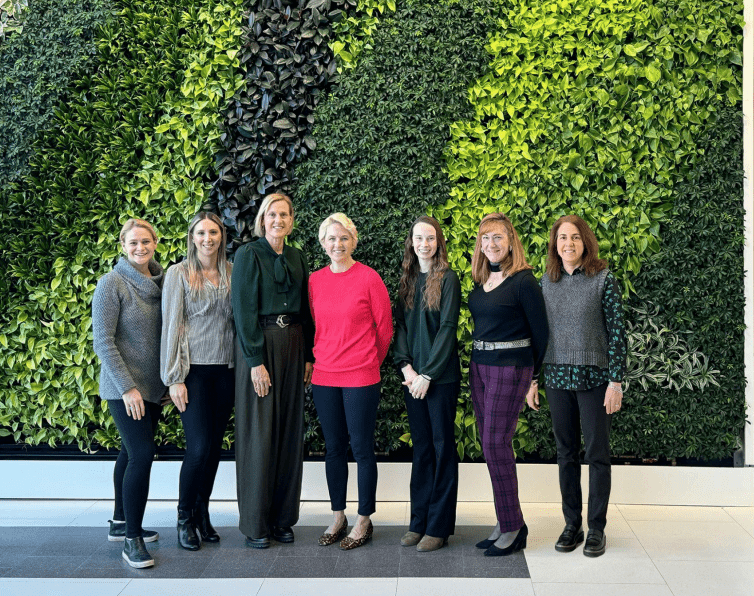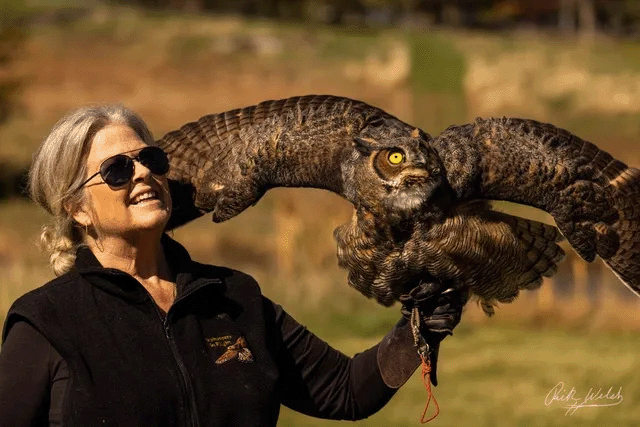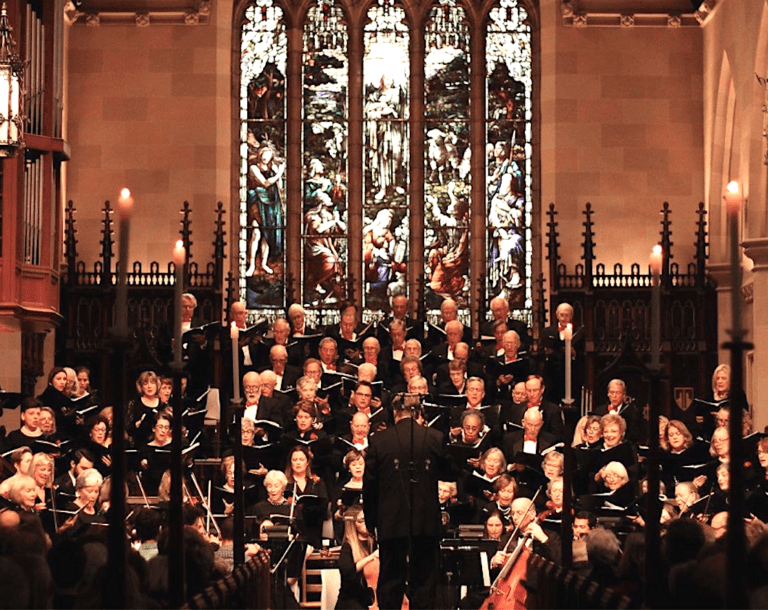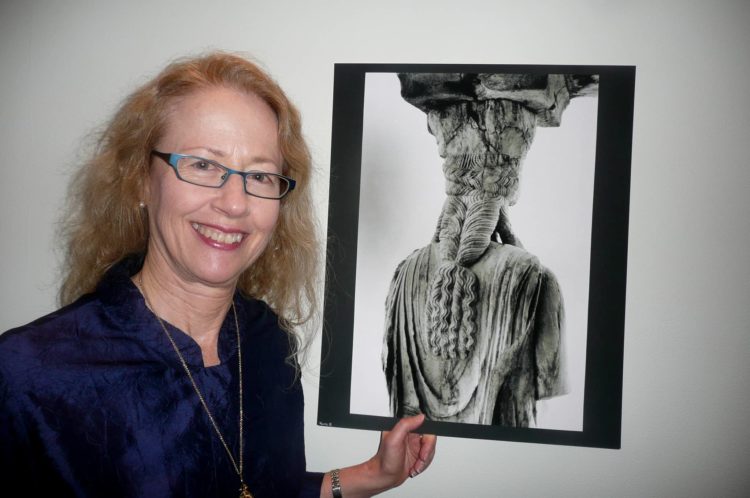
Nancy Bernard RIP – She opened the door to so many of the wonders of the ancient world
By Anne W. Semmes
We’re gathered in the lecture hall of the Bruce Museum. The lights go out and the lecture begins, the images of the ancient past entrance as the archaeologist or professor spins out his or her tale. If its Bob Brier, known as Mr. Mummy with his knowledge of things Egyptian, we see the story of the transfer from Egypt of the ancient obelisk, Cleopatra’s Needle to its place behind the Metropolitan Museum of Art. Or Kathy Schwab, Professor of Art History & Visual Culture at Fairfield University, challenges us with accepting that those famous marble metopes of the Parthenon were originally in color.
An unforgettable image I have is of Kathy’s female students poised on the campus lawn standing as the Caryatid maidens do on the Acropolis with their long hair arranged like those maidens’ ancient Greek hair styles. “Nancy Bernard contacted me when I first began teaching at Fairfield University in 1988,” says Kathy. “Before I knew it, I was invited to give a lecture for her Archaeological Associates of Greenwich (AAG), the first of several invited lectures over the years…Dinners before giving a lecture were always a happy occasion to catch up on news, archaeological issues, and travels.”
“Nancy was a person of boundless energy, great intelligence, and endless good will,” offers Mr. Mummy, Bob Brier. “She delighted in bringing people together and was beloved by all in Archaeology. May she have life, health, and prosperity, like Re [Sun King of the Egyptian Gods] forever.” Bob became a friend with the many times he came to speak about his Egyptian discoveries. How I wish my young grandson Arthur could have been with me learning about the Cheops Boat, the largest and one of the oldest boats ever excavated, dating from approximately 2,500 BC.
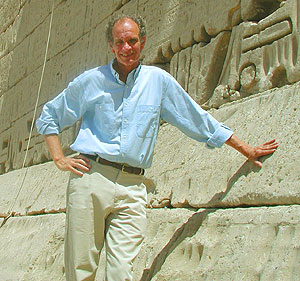
Arthur would also have loved handling those stone age tools Nancy and her docents would introduce to some 75,000 sixth grade students in public and private schools in Fairfield and Westchester Counties over a period of 40 years. What impresses Renee Seblatnigg, one of a dozen and more docents serving those students with Nancy was how she introduced her Early Man Project in 1975. “Nancy came cold to town – she didn’t know Greenwich. She came from California…She had been in this [Early Man Project] program at the Museum of Cultural History at UCLA and using tools from their Wellcome Collection.”
Nancy’s Stone Age Tools, on loan from UCLA’s Fowler Museum, were collected across Europe, Africa and the Near East by American-born Sir Henry Wellcome, the pharmaceuticals magnate. “Nancy was a lithics scholar,” notes Seblatnigg. “She joined the League of Women Voters, which is something she’d done in California…She was forming a plan thinking there’s nothing like this [Early Man Project] in Greenwich, and the kids do study early man. In most settings, you see collections like this in museums, but the kids are being able to hold prehistoric tools and understand that the people that use them had brains…and the kids were fascinated.”
Nancy would say, “These are the stone age tools of prehistoric peoples –the real thing.”
I was able once to handle those tools laid out on Nancy’s Belle Haven porch. Picking up a small hand axe she described it as having, “the longest use of any tool, at 800,000 years.” She showed me how those early men – and surely women would use a “hammer” stone to break off a flake from a flint stone then use those flakes to “scrap off skins at the height of the ice ages.”
The Bruce Museum had stepped up to sponsor Nancy’s renamed Prehistoric People Program, folding it into its traveling Brucemobile education program. But in 2005, that sponsorship came to an end, though luckily the AAG lectures continued for a few years.
Nancy added impressively to my library, starting with her own published book on “Stonehenge” she co-wrote with a distinguished British archeologist that is accessible to young people. It begins, “The greatest rock group of Britain? It’s not a band. It’s Stonehenge.” (This book is destined for my grandson Arthur.) From her library I was also gifted, appropriately, “The Story of Writing,” and “Everyday Life in Ancient Times,” made real with that lecture given by Professor Ann Olga Koloski-Ostrow of Brandeis University, that focused on the Professor’s specialty – the archaeology of sanitation in Roman Italy.
Koloski-Ostrow was to share her new research in her talk entitled, “New Light on Dark Pompeian Places: Baths, Brothels, Sewers, and Toilets.” She was pleased to see Nancy and “her lively audience” eager to hear of “a completely different perspective on ancient Roman life from the more grandiose, aristocratic view one usually hears about in lectures.”
The questions Koloski-Ostrow received afterward, she shares, “especially from Nancy herself, who was sharp as a tack, kind, thoughtful, and insightful, moved me in new directions that ultimately led me to publish a whole book on the subject: “The Archaeology of Sanitation in Roman Italy: Toilets, Sewers, and Water Systems.”
It was on a trip to Israel in the 1970’s with husband Allan that Nancy first became enthralled with archaeology, helped along by reading James Michener’s “The Source,” as she wrote in her memoir, “My Story.” Her longtime friend Kirk Ferguson from Katonah, NY. had traveled with her to Libya, “the last trip Americans were allowed to take to Libya,” Kirk recalls. Traveling in the month of November, “a terrible storm came up in the Mediterranean. Nancy and the ship doctor were the only two passengers able to make three meals a day in the dining room! The rest of us were sick as dogs. Nancy’s only comment was, ‘Well, the Phoenicians had it right. They would only sail these waters between April and September.’”
Nancy would travel often with her fellow docents. Joan Schiele, one of the very first to sign on, joined Nancy and fellow docent Elizabeth Brunner on UCLA digs in Italy and Greece, over several seasons analyzing and dating early stone tools. “She was a wealth of knowledge,” says Brunner of Nancy. “To this day I have those vivid memories. Her love of history – her love of Archaeology was self-evident.”
This reporter never had the chance sadly to travel with Nancy, but she encouraged me to travel virtually to ancient sites by attending conferences held by the Archeological Institute of America (AIA) in both San Francisco and Boston. One could choose from a variety of digs and meet distinguished archaeologists. Surely Agatha Christie would have liked such a crowd.
So, too bad the new Bruce Museum didn’t consider restarting those illustrative AAG lectures they unfortunately discontinued years ago. Fortunately, Nancy’s three sons have chosen to memorialize their mom with a few lectures a year to be hosted by the Byram Shubert Library, thanks to the interest of its Branch Manager, Miguel Garcia-Colon. So, we will once again have those magical doors open to the ancient world that had so gripped dear Nancy Stone Bernard.

